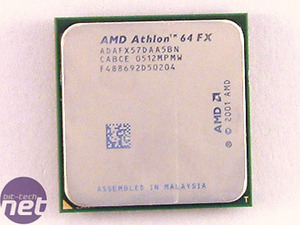

Today, AMD go back to the single threaded arena, releasing their next Athlon 64 FX-series processor: the FX-57, which is designed to deliver flagship gaming performance to the bleeding edge gaming enthusiast. Over the next few pages, we will have a look at how this holds true, as well as how it performs in some of the other CPU-intensive tasks that you are likely to perform on your system during day-to-day use.
In essence, there isn't a great deal of new ground to cover with the Athlon 64 FX-57; it is 200MHz faster than the FX-55, meaning that it is clocked at a healthy 2800MHz. One would expect the former to deliver slightly higher performance than the latter, as with the gap between FX-53 and FX-55 that we experienced at the back end of last year.
However, that is not all that is going on with the Athlon 64 FX-57. It is built on a fabrication process that is new ground for Athlon 64 FX-series processors, making it unique in comparison to other members of the FX-series, which have thus far been manufactured on a 130-nanometre process until now. Along with the process change, there is also the inclusion of SSE3 instructions, an improved memory controller and improved multimedia performance.

The main difference between Venice and San Diego are that the latter has a larger L2 cache - 1MB as opposed to 512KB on the Venice core. In terms of cache, the FX-57 is no different to any other Athlon 64 FX - this one also has a 1MB L2 cache. Thus, you would be right in making the assumption that the FX-57 is based on the San Diego core.
The operating voltage has decreased from 1.50V on the FX-55, down to 1.40V on the FX-57, thanks to the process shrink. Also, the die size is roughly half that of all previous Athlon 64 FX's due to the process shrink, meaning that the FX-57 should be a more cost effective CPU for AMD when compared to its 130-nanometre siblings. The final thing to note about the processor is that, despite the 200MHz increase in clock speed, it actually runs cooler than an FX-55, and also uses less power than it - again, this is down to the process shrink. Wouldn't it be great if all process shrinks had these benefits?

MSI MPG Velox 100R Chassis Review
October 14 2021 | 15:04






Want to comment? Please log in.